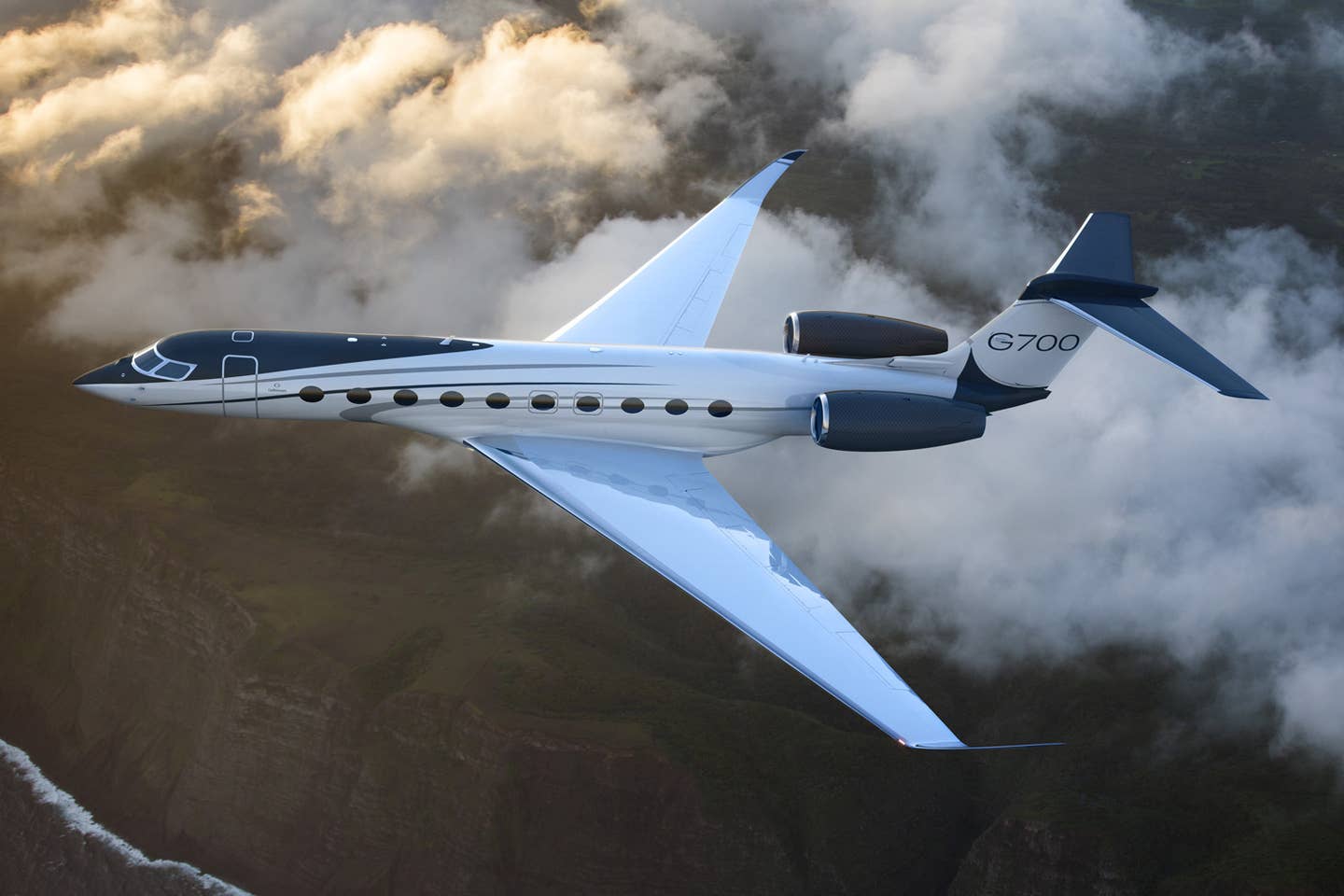
The G700 is Gulfstream’s new flagship aircraft, leveraging testing from the G500 and G600.
GulfstreamGulfstream announced the G700 last night, the Savannah, Georgia-based airframer's new entry into the ultra-long-range aircraft category—a model clearly aimed at Bombardier's Global 7500. Also announced were two new fleet operators of the G700 that will help keep the assembly lines busy until 2023, the next delivery opportunity. Flexjet will serve as the G700's launch customer in the U.S., while Qatar Airways serves a similar role overseas.
The cabin of the G700 is long–nearly 57 feet, excluding the baggage area–a number that bests the G650ER by four feet and offers operators the option for five distinct living areas, or four if they choose a Part 135-compliant crew rest station. When finished, the G700’s cabin is 6 feet 3 inches tall and 8 feet 2 inches wide. The G700 will carry as many as 19, while berthing up to 10.
Powered by two new Rolls-Royce Pearl 700 engines specifically designed for this new Gulfstream, the G700 will deliver a maximum cruise speed of Mach 0.925. Gulfstream said much of the thinking behind the new G700 emerged from the positive technological and customer experiences derived while created the G500 and G600, although the 700 includes plenty of brand-new technology that will amaze both the cockpit crew and passengers in the cabin. The G700 is also expected to also share a common type rating with the earlier 500 and 600.
The G700 interior is sure to delight owners and operators with a private stateroom option that includes four large G650-size windows, as well as a private shower to freshen up after a journey that might extend to the G700’s maximum range of 7,500 nm range. The rest of the cabin is inundated with more of those large G650-style windows totaling 10 on each side of the fuselage. The cabin uses 100 percent fresh air all the time and offers four complete zone controls to moderate the environment. At 41,000 feet, the G700 holds the cabin down to 3,300 feet while at 51,000 feet, the cabin climbs only another 1,500 feet. What passengers will really enjoy in the G700 cabin is the spectacular audio system that includes no speakers. New to this airplane Gulfstream’s 3D audio system that actually turns the sidewalls into speakers capable of delivering rich high-frequency sound and impressive, wall-shaking base as near to surround sound as most people have ever experienced. The new Gulfstream includes a host of new technologies for passengers to control their media experience using their own devices, as well as cleverly concealed plugs to charge everything.
Another important part of the new G700’s cabin is a galley counter that stretches more than 10 feet in length and to allow more than one person at a time to prepare meals or snacks. The airplane includes special rear-cabin table that stretches across the aisle to seat six but requires no external table leaf.
Everyone will enjoy the G700’s cabin lighting that’s offered in two versions. The HD uses thousands of bright white, soft white and amber LEDs to set the color of the cabin temperature, while the advanced Ultra HD system uses 20,000 LEDs and offers 68,000 different possible light settings. Best of all, either of the two LED lighting system are capable of emulating natural light from sunrise to sunset that can also be correlated to the passenger’s natural circadian rhythm, no matter where the flight began.
Up front, the G700 comes standard with the active sidesticks the G500 and G600 first brought to the marketplace. The Symmetry flight deck, based on Honeywell’s Primus EPIC, is standard, as are dual head-up displays and autobrakes. Gulfstream co-created its new predictive landing performance system with Honeywell. In the landing configuration, the runway appears visually on the PFD’s speed tape clearly indicating where the aircraft can be expected to stop depending on speed and autobrake setting. Total aircraft energy is computed by adding altitude. If the system detects the airplane is too high or too fast to safely halt the G700 on the runway in use, it will issue the crew a “Go Around,” command, one of the few times Gulfstream makes a decision for the pilot. Of course there’s no regulation that says pilots must obey the command, but Gulfstream still expects it to help reduce runway overruns with the added safety net the system provides.
Gulfstream president Mark Burns, a 37-year employee, offered Flying a few insights on the new G700, the 12th airplane he's had a hand in certifying as a company employee. He began by detailing the involvement of the maintenance people early in the G700's development. "One of our goals was to be able to remove anything on the G700 in under 30 minutes," with the only exception being an engine. Gulfstream of course builds only business jets. "We build airplanes to help customers be more productive … to ensure they're successful," Burns said. "When we build an airplane, we also want to be their service provider for 40 years. We want to be the owner of the [maintenance] facility, to have control of how that experience happens for our customer, and understand their experience." To help gain the needed feedback, Burns told Flying, "the first thing that I do every morning is read customer surveys, because I think it's important to know how people feel about your product and your people."
No first flight or tentative delivery dates have yet been announced for the Gulfstream G700. The new aircraft is currently priced at $76 million for the next delivery slot available in 2023.

Sign-up for newsletters & special offers!
Get the latest FLYING stories & special offers delivered directly to your inbox






